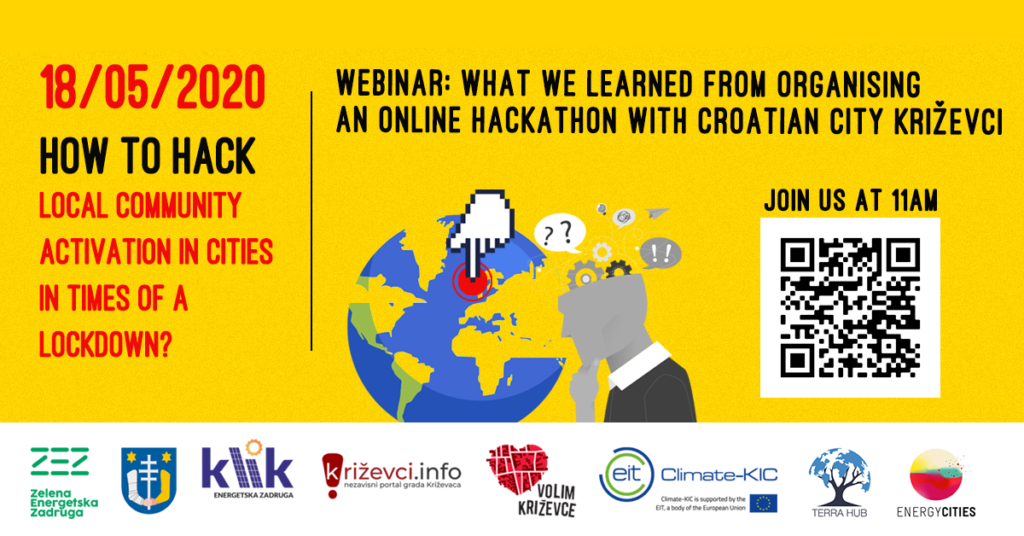Two fights at a time: Cities’ combined responses to the sanitary and climate crises
Local actions for a greener & healthier future!
After almost 3 months, most European cities are now slowly coming out of lockdown, trying to instil some “normality” back into their citizens’ life. At Energy Cities, we have had the chance to be in regular contact with local authorities, cities and regions who have been at the frontline of the fight against the corona virus. We have heard about the challenges they have met, and the solutions they have found.
While coping with the pandemic, many local governments started reflecting on their future. How to come out of the crisis stronger?
Citizens reimagining their cities
Some municipalities asked their citizens for support, and the latter showed amazing resourcefulness and willingness to engage!
In Germany, the municipal archives of Chemnitz initiated “Chemnitz is resisting – my dream for tomorrow”, asking citizens to share their reflections and stories about the present time, to leave a trace of their experience for future generations.
Krizevci’s municipality (Croatia) launched the challenge “Today for Tomorrow: Upgrade the system and restart Križevci Version 20.30”. They invited everyone to a 24-hour online hackathon to imagine the green city of the future. The experiment was a huge success and participants put many ideas forward, such as a mobile solar-powered kiosk to collect samples for testing. The kiosk would relieve the pressure from medical institutions and would allow easier access to citizens.

The city of Nice (France) launched an online platform to “redefine the city of tomorrow”. They ask their inhabitants to contribute with ideas and tell them how they would like Nice to transform after the crisis is over.
Adopting new economic models
Other cities started to re-think their economic model. “We don’t want to go back to the same economy we had before” told Mayor of Delft Stefan Brandligt, during one of our weekly conversation with members. “But we are not asking for autarchy either, we need multilevel cooperation… This is the only way to keep the European Union together. They need to be future-oriented in the way they deliver the help”.
We don’t want to go back to the same economy we had before
Stefan Brandligt, Mayor of Delft
Of course, the more international cities are, the more exposed to the crisis. Heidelberg (Germany), for example, welcome 12 million tourists a year and its local economy is highly dependent on this activity. “We are already looking into ways of promoting more local sustainable tourism”, said Mayor Eckart Würzner. “We are adopting sustainable measures and we hope to be supported at national and EU level”.
We are adopting sustainable measures and we hope to be supported at national and EU level
Eckart Würzner, Lord Mayor of Heidelberg
Their requests are not isolated. In the past few weeks, cities joined forces to ask support for a green recovery – read our Letter to European Commission’s President and the EU Covenant of Mayors Board’s open letter.
The city of Amsterdam went even further: they adopted the famous “Doughnut Model”, to make sure they can prosper within the planet’s ecological boundaries. Kate Raworth from Oxford University’s Environmental Change Institute developed the model in 2017. It looks at how to fulfil everyone’s needs while respecting the planet’s boundaries. The economist herself scaled it down to provide them with an overview of unmet needs.
Supporting local businesses and shorter food chains
Many cities looked closer at their production systems. In France, the disruption of distribution channels brought by the crisis lead customers back to local producers. To support the process, the Brittany region created an online platform connecting local producers with consumers. The platform was launched at the beginning of April and 10 days later already counted 44,000 customers and 1,205 producers! The administration of Brest Metropolitan Area took a similar initiative they created an interactive map of local producers, where citizens can easily find out the most convenient option and get in touch with the producer of their choice.

In Leuven (Belgium) the local food distribution platform Kort’om, created a food vending machine, which allows customers to safely purchase and collect locally produced food, vegetables and dairy products. The vending machine is located in the city centre, but it will disappear once the coronavirus measures are over.
One of Brussels municipalities launched an e-commerce platform dedicated to the local shops called “MaZone” (“MyZone” in English – a nod to the e-commerce giant we all know). Once the customer has placed the orders, each shop owner will deposit the products in a communal warehouse, from where they will be dispatched by bicycle.
Fast tracking sustainable mobility measures
Bikes have been the main protagonist of our streets in the past months. Social distancing rules have heavily affected public transport in most cities, and many local governments – Milan, Paris, Brussels and Valencia to name a few – concluded that making soft mobility easier was the cheapest and safest response, to avoid a steep increase of infections… and pollution levels.
“We had some of these measures already planned before the crisis, but this situation definitely speed up implementation”, said an employee of Valencia city council (Spain). According to Stefan Brandligt, Mayor of Delft (the Netherlands): “Invest additional resources [in bike routes and pedestrian areas] was the most convenient thing to do, also for cities like Delft who already had 40% bike mobility”.

These positive developments in times of crisis (and the many others we could not feature!) are giving us hope. However, cities’ sustainable future is still on the line: will local governments be able to maintain and even reinforce the green measures taken during the past months? Will they manage to combine the local economy approach while staying open to the rest of the world? And the most important question maybe: will we be able to channel this renewed sense of urgency and the consequent collective engagement into actions for the climate and the energy transition?

